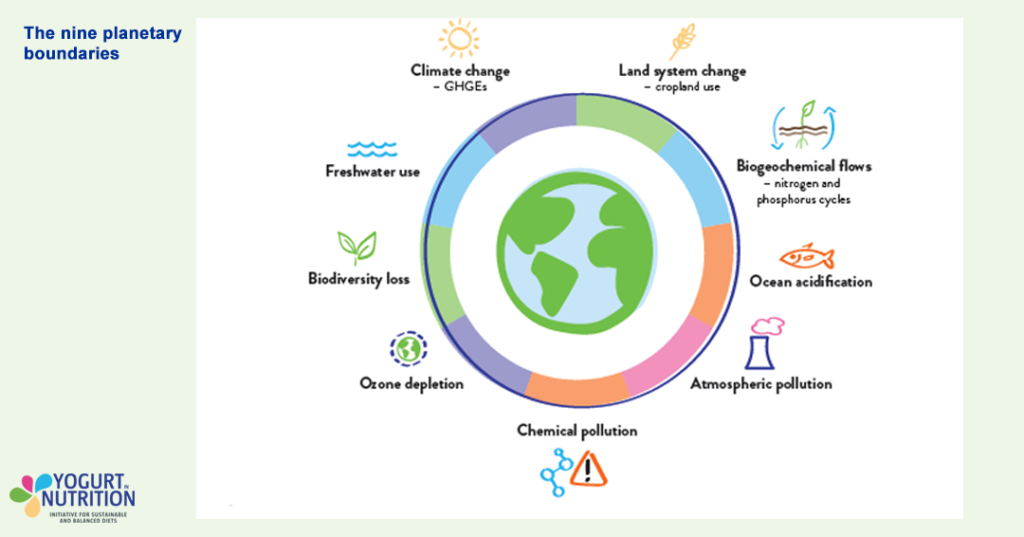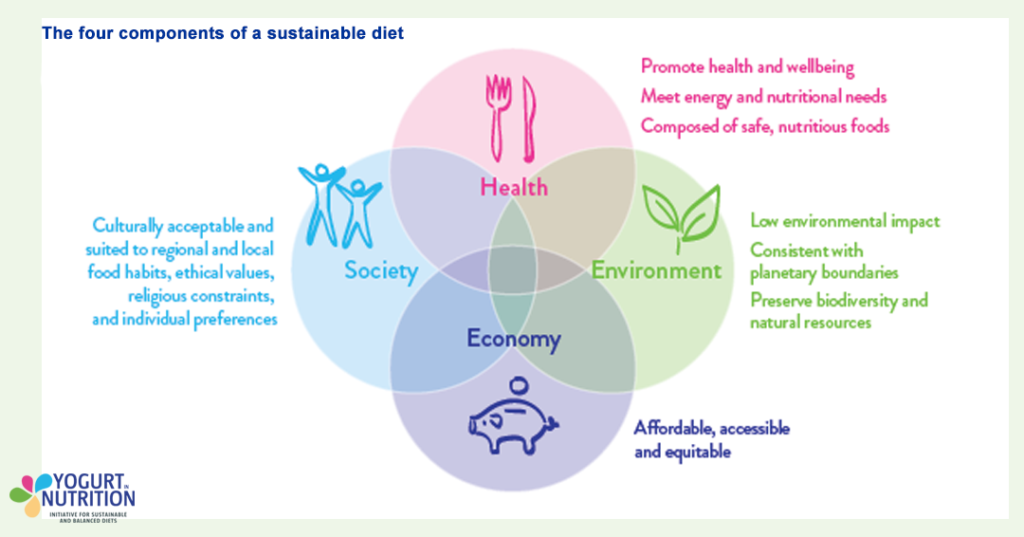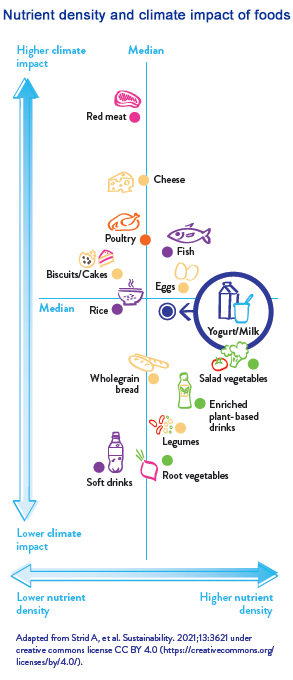Sustainable diets aim to balance planetary and human health; they are defined as nutrient-rich, affordable, accessible, and culturally acceptable, as well as having a relatively low environmental impact.
To ensure a diet is sustainable, the entire food system – including production, processing, distribution, consumption, and disposal – must be considered. Within this context, scientific models show that dairy products, including yogurt, may have a role to play in sustainable diets and food systems.
The characteristics of food systems should allow human impact to stay within planetary boundaries. These boundaries represent the systems that are crucial for regulating and maintaining the stability of our planet. Together, they define global limits within which humanity should operate to ensure a stable and resilient environment. Local, regional, and global food systems should operate within these planetary boundaries to produce foods that contribute to sustainable diets worldwide.
Today’s food systems are one of the biggest reasons why we exceed planetary boundaries, responsible for up to 35% of greenhouse gas emissions (GHGEs), 48% of cropland use, and 70% of freshwater use, with high impacts on forests and loss of biodiversity.

The 2019 report of the EAT-Lancet Commission,196 along with recent global events such as United Nations (UN) Climate Change Conferences and Food Systems Summits, have all called for a switch to diets that are made up of foods produced through sustainable food systems – which incorporate environmental improvements in food production, processing and distribution and reduced food loss and waste.
Sustainable diets must balance health, environmental, social, and economic impacts
However, a sustainable diet is more than just a dietary pattern with a low environmental impact. A sustainable diet represents an acceptable compromise between health, environmental, social, and economic factors, described by the UN’s Food and Agriculture Organization (FAO) and the World Health Organization (WHO).
Scientists have demonstrated that the best balance between these dimensions of a sustainable diet can be achieved by adopting varied, plant-based diets, such as flexitarian, planetarian, or territorial diets:
- Flexitarian and planetarian diets – designed to be healthy for both people and planet – combine a large number of plant-based foods with low levels of red meat and moderate amounts of poultry, fish, eggs, and dairy.
- Territorial diets, such as the Mediterranean diet, are region-specific flexitarian diets composed mainly of seasonal, locally sourced foods.
“Dairy foods, including yogurt, play a key role in sustainable flexitarian diets. They provide an affordable source of high-quality protein, are definitely the lowest cost source of calcium and other bone-building nutrients, and havea much lower carbon cost than meat.” -Professor Adam Drewnowski
Dairy products can be part of sustainable diets
Scientists use dietary models to predict how individual food changes will affect the overall nutritional quality and environmental impact of a particular diet. Several diet-modelling studies have found that dairy products can be part of theoretical sustainable diets in adults with a Western-style diet. For such adults, the dietary changes that most effectively reduce environmental impact while remaining consistent with dietary guidelines for health are:
- To eat fewer calories overall
- To eat less meat especially red and processed meats
- To introduce pulses, legumes, nuts, and seeds
- To eat more fruits, vegetables, and wholegrains.
Within this framework, maintaining nutrient-dense dairy foods as part of a sustainable diet can help individuals to satisfy their nutritional needs while consuming less meat and more plant-based foods. Fortified plant-based dairy-like products may also play a role in sustainable diets alongside dairy products.
In a diet modelled to reduce dietary carbon footprint by 30% while improving nutritional intakes and staying as close as possible to the diet of French adults, eating fortified plant-based dairy-like products – such as calcium-enriched soya drinks and yogurt-alternatives – alongside traditional dairy products helped to improve diet sustainability, especially in women with low energy intakes.
Recent public health guidance for sustainable diets includes a role for dairy products
The role of dairy products – including yogurt – as part of a plant-based, low-meat flexitarian diet is supported by global, regional, and local recommendations for sustainable diets:
- A moderate dairy intake of around 250 g (~9 ounces) per day that respects nutritional recommendations can form part of a sustainable diet, according to global recommendations published by FAO/WHO and the EAT-Lancet Commission.
- Modelling studies in regions including France, Nordic countries, and the UK have adapted a global flexitarian diet, including the role of dairy products, to be consistent with local dietary guidelines, cultural considerations, and food systems.
The role of dairy products as part of a flexitarian diet may vary depending on location, due to geographic differences in methods of production, local patterns
of consumption, and population-specific nutritional needs.
Several characteristics of yogurt support its contribution to sustainable diets and food systems
1) Health and nutrition: Yogurt is a nutrient-rich food with health benefits
Eating yogurt daily is an effective way of meeting nutritional requirements with a balanced energy intake – yogurt contains high-quality proteins and essential
nutrients including calcium, potassium, magnesium, iron, zinc, and numerous vitamins.
Yogurt also contains lactic acid bacteria, which have been shown to benefit gut health and digestion. Eating yogurt has been associated with a variety of additional
health benefits, including improvements in weight management and reductions in risk of Type 2 diabetes, metabolic syndrome, and cardiovascular disease.
2) Environment: Yogurt has a smaller footprint than some other animal foods
Within the range of animal-based foods, scientists recommend eating less meat – especially beef – to achieve the greatest environmental and health benefits. One study found that reducing the consumption of red meat has an environmental benefit around five times greater than reducing the consumption of dairy products, when considering GHGEs, land use, water footprint, and soil pollution.
The environmental footprint of individual foods should be weighed against the nutrient content they provide.
Life-cycle assessments show large differences in both nutrient density and environmental impact among foods. In such analyses, yogurt scores above average for nutrient density and slightly below average for climate impact.
Carbon footprint (GHGEs)
Greenhouse gasses are released at every stage of the food production and consumption cycle – from farming and agricultural practices to packaging, transport and storage in the supermarket and the home, as well as during waste management. Beef and lamb consumption generates around ten times the GHGEs per serving as pork, poultry, and dairy products, which have around ten times the GHGEs of plant-based foods, such as grains, fruits, and vegetables.
Some studies have found that yogurt compares favourably with many other animal foods in terms of GHGEs for the level of nutrition it provides.
These studies estimated that yogurt production has a smaller carbon footprint than that of red meat, poultry, and cheese production, similar to that of milk.
Water footprint, land use, and biodiversity
Animal-sourced foods generally have a higher impact on land and water use than plant-based foods, with particularly large impacts for the production of red meat. Some studies have found that yogurt production might have a relatively lower impact on biodiversity loss, land use and fresh water use, compared with other animal products such as cheese and meat.
Regenerative dairy farming practices
Scientists estimate that current land and water use for farming is 52–60% above the targets set for limiting biodiversity loss and freshwater withdrawals.216 Recent improvements in the production and processing of dairy products have helped strengthen their role in sustainable food systems and may help to address this imbalance. Regenerative farming practices improve land use and farming techniques to help enhance soil health and biodiversity, reduce water use and food loss, increase carbon storage and reduce GHGEs, reducing the impact of dairy products on the environment.
Studies show that regenerative dairy farming practices can compensate for up to 28% of GHGEs through soil carbon sequestration.222 Improvements to livestock management through feeding changes, selective breeding, and manure management can also help to reduce methane emissions from dairy herds by up to 15–20%.
3) Society: Yogurt is part of local cultures in many regions
Dietary choices are often driven by the customs, religion, and culture of specific countries and regions. Fermented dairy products such as yogurt can be found in many geographies worldwide and are already staple foods in many cultures, with different types including:
- Amasi and Maas (Africa)
- Dahi and Lassi (Bangladesh, India and Pakistan)
- Chal and Kumia (Central Asia)
- Kefir, Smetana, and Ayran (Europe)
- Labneh, Laban, and Kushk (Middle East)
- Yogurt and Curd (Worldwide)
4) Economy: Yogurt can be affordable and contribute to local economic welfare
Food profiling studies show that yogurt is an affordable source of high-quality proteins and other essential nutrients in many countries and is one of the most affordable sources of calcium. When comparing the costs of different foods per calorie, dairy products including yogurt cost less than meat, poultry, and fish, and are more comparable with the per-calorie cost for beans and eggs.
The affordability of dairy products enables a variety of uses and their incorporation into various dietary patterns and food traditions in different countries and cultures.46 The production of fermented foods, such as yogurt, is a natural and simple process that provides access to safe and healthy food, creates demand for local produce, and provides employment and income opportunities.Fermentation can also be a good way of producing more sustainable food sources by reducing agricultural and food processing wastage.
References:
-
Drewnowski A. Measures and metrics of sustainable diets with a focus on milk, yogurt, and dairy products. Nutr Rev. 2018;76:21–8.
-
Kok CR, Hutkins R. Yogurt and other fermented foods as sources of health-promoting bacteria. Nutr Rev. 2018;76(Suppl1):4–15.
-
World Health Organization, Food and Agriculture Organization of the United Nations. Sustainable healthy diets: guiding principles. October 2019.
-
EAT Forum. EAT-Lancet Commission Summary Report. July 2019.
-
Steffen W, Richardson K, Rockström J, et al. Planetary boundaries: Guiding human development on a changing planet. Science. 2015;347:1259855.
-
Moreno LA, Meyer R, Donovan SM, et al. Perspective: Striking a Balance between Planetary and Human Health-Is There a Path Forward? Adv Nutr. 2022;13:355-75.
-
Colao A, Vetrani C, Muscogiuri G, et al. “Planeterranean” Diet: extending worldwide the health benefits of Mediterranean Diet based on nutritional properties of locally available foods. J Transl Med. 2022;20:232.
-
Dussiot A, Fouillet H, Perraud E, et al. Nutritional issues and dietary levers during gradual meat reduction – A sequential diet optimization study to achieve progressively healthier diets. Clin Nutr. 2022;41:2597–606.
-
Gazan R, Vieux F, Lluch A, et al. Individual Diet Optimization in French Adults Shows That Plant-Based “Dairy-like” Products May Complement Dairy in Sustainable Diets. Sustainability. 2022;14:2817.
-
Perraud E, Wang J, Salomé M, et al. Dietary protein consumption profiles show contrasting impacts on environmental and health indicators. Sci Total Environ. 2023;856:159052.
-
Rocabois A, Tompa O, Vieux F, et al. Diet Optimization for Sustainability: INDIGOO, an Innovative Multilevel Model Combining Individual and Population Objectives. Sustainability. 2022;14:12667.
-
Mertens E, Kuijsten A, Kanellopoulos A, et al. Improving health and carbon footprints of European diets using a benchmarking approach. Public Health Nutr. 2020;24:565–75.
-
Hess J, Rao G, Slavin J. The Nutrient Density of Snacks: A Comparison of Nutrient Profiles of Popular Snack Foods Using the Nutrient-Rich Foods Index. Glob Pediatr Health. 2017;4:2333794X17698525.
-
Chalupa-Krebzdak S, Long CJ, Bohrer BM. Nutrient density and nutritional value of milk and plant-based milk alternatives. Int Dairy J. 2018;87:84e92.
207.
-
Karlsson JO, Carlsson G, Lindberg M, et al. Designing a future food vision for the Nordics through a participatory modeling approach. Agron Sustain Dev. 2018;38:59.
-
World Wildlife Foundation UK. Eating for 2 Degrees: New and Updated Livewell Plates. August 2017.
-
World Wildlife Foundation France. Towards A Low-Carbon, Healthy and Affordable Diet. November 2017.
-
Ridoutt BG, Baird D, Hendrie GA. The role of dairy foods in lower greenhouse gas emission and higher diet quality dietary patterns. Eur J Nutr. 2021;60:275–85.
-
Comerford KB, Miller GD, Reinhardt Kapsak W, et al. The Complementary Roles for Plant-Source and Animal-Source Foods in Sustainable Healthy Diets. Nutrients. 2021;13:3469.
-
Vieux F, Rémond D, Peyraud J-L, et al. Approximately Half of Total Protein Intake by Adults Must be Animal-Based to Meet Nonprotein, Nutrient-Based Recommendations, With Variations Due to Age and Sex. J Nutr. 2022;152:2514–25.
-
Mertens E, Kuijsten A, van Zanten HHE, et al. Dietary choices and environmental impact in four European countries. J Clean Prod. 2019;237:117827.
-
Clark MA, Springmann M, Hill J, et al. Multiple health and environmental impacts of foods. Proc Natl Acad Sci USA. 2019;116:23357–62.
-
Strid A, Hallström E, Sonesson U, et al. Sustainability Indicators for Foods Benefiting Climate and Health. Sustainability. 2021;13:3621.
-
Global Nutrition Report. 2021 Global Nutrition Report: The state of global nutrition. 2021.
-
Clark M, Springmann M, Rayner M, et al. Estimating the environmental impacts of 57,000 food products. Proc Natl Acad Sci USA. 2022;119:e2120584119.
-
Walker C, Gibney ER, Hellweg S. Comparison of Environmental Impact and Nutritional Quality among a European Sample Population – findings from the Food4Me study. Sci Rep. 2018;8:2330.
-
International Dairy Federation. UN Food Systems Summit: Game changing solutions for dairy. March 2021.
-
Climate and Clean Air Coalition, United Nations Environment Programme. Global Methane Assessment: Summary for Decision Makers. 2021.





